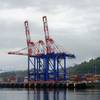Overall confidence levels in the shipping industry fell to a record low in the three months to February 2016, according to the latest Shipping Confidence Survey from international accountant and shipping adviser Moore Stephens.
The average confidence level expressed by respondents in the markets in which they operate was 5.0 on a scale of 1 (low) to 10 (high).
This compares to the 5.6 recorded in November 2015, and is the lowest rating in the life of the survey, which was launched in May 2008 with a confidence rating of 6.8.
All main categories of respondent with the exception of brokers (up from 4.6 to 5.1) recorded a fall in confidence this time, most notably charterers (down from 5.5 to 3.9), which is the lowest confidence rating by any category of respondent in the history of the survey.
Confidence on the part of owners and managers was also down, from 5.7 to 4.8 and from 5.8 to 5.5 respectively.
Geographically, confidence was down in all major areas covered by the survey – in Asia from 6.0 to 4.4, in Europe from 5.4 to 5.1, and in North America from 5.7 to 4.7.
A number of respondents continued to express concern about the level of overtonnaging, with one pointing out, “Newbuilding deliveries for 2016 will increase the total fleet by 10.5%, 7% of the current fleet is older than 20 years, and cargo volumes in 2015 were just 4.5% higher than in 2014, so the expected available fleet per metric ton of dry cargo available will be higher at the end of 2016 than it is now. As a result, there is no chance of freight levels improving.”
Another respondent said, “As long as shipowners operate based on hope rather than on solid economics, there will always be booms and busts.”
Particular concern was expressed about the state of the dry bulk market, with one respondent commenting, “No dry bulk business makes any remote sense. There are too many players, too many operators, and too many vessels chasing too few cargoes. Most fixtures are concluded merely to keep the banks happy in the belief that some tiny amount of cashflow is coming in.”
Elsewhere it was noted, “Dry bulk is simply at the bottom of the bottom, and actually a little lower than that.”
The dry bulk sector, meanwhile, looks especially troubled, with one respondent to our survey claiming that new historic lows in dry bulk freight rates are being set every day.
Reports suggest, however, that more and younger dry bulk vessels are being recycled in spite of weak demolition rates, and contrary to the trend with other categories of tonnage.












